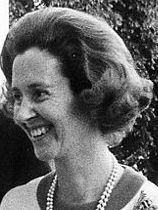Fabiola de Mora y Aragón
| Fabiola de Mora y Aragón | |||||
|---|---|---|---|---|---|

Queen Fabiola on a state visit to Washington, D.C. in 1969
|
|||||
| Queen consort of the Belgians | |||||
| Tenure | 15 December 1960 – 31 July 1993 | ||||
| Born |
11 June 1928 Zurbano Palace, Madrid, Kingdom of Spain |
||||
| Died | 5 December 2014 (aged 86) Stuyvenberg Castle, Laeken, Kingdom of Belgium |
||||
| Burial | 12 December 2014 Church of Our Lady of Laeken |
||||
| Spouse | Baudouin of Belgium | ||||
|
|||||
| Father | Gonzalo de Mora Fernández Riera del Olmo, Marqués de Casa Riera | ||||
| Mother | Blanca de Aragón y Carrillo de Albornoz Barroeta-Aldamar y Elío | ||||
| Religion | Roman Catholicism | ||||
| Full name | |
|---|---|
| Fabiola Fernanda María-de-las-Victorias Antonia Adelaida |
Fabiola de Mora y Aragón (11 June 1928 – 5 December 2014) was Queen of the Belgians from her marriage to King Baudouin in 1960 until his death in 1993. The couple had no children, so the Crown passed to her husband's younger brother, King Albert II.
Fabiola de Mora y Aragón was born in Madrid, Spain, at the Palacio Zurbano, the main residence of the Marqués de Casa Riera. She was the sixth of seven children of Don Gonzalo de Mora y Fernández y Riera y del Olmo, 4th Marqués de Casa Riera, 2nd Count of Mora (1887–1957), and his wife, Doña Blanca de Aragón y Carrillo de Albornoz y Barroeta-Aldamar y Elío (1892–1981), daughter of the 6th Marchioness of Casa Torres and Viscountess of Baiguer. Her godmother was Queen Victoria Eugenia of Spain.
Before her marriage she published an album of 12 fairy tales (Los doce cuentos maravillosos), one of which ("The Indian Water Lilies") would get its own pavilion in the Efteling theme park in 1966.
On 15 December 1960, Fabiola married Baudouin, who had been King of the Belgians since the abdication of his father, Leopold III, in 1951. At the marriage ceremony in the Cathedral of St. Michael and St. Gudula, she wore a 1926 Art Deco tiara that had been a gift of the Belgian state to her husband's mother, Astrid of Sweden, upon her marriage to Leopold III. Her dress of satin and ermine was designed by the couturier Cristóbal Balenciaga. Fabiola was a hospital nurse at the time of her engagement; TIME magazine, in its 26 September 1960, issue, called Doña Fabiola the "Cinderella Girl" and described her as "an attractive young woman, though no raving beauty" and "the girl who could not catch a man." On the occasion of her marriage, Spanish bakers set out to honour Fabiola and created a type of bread, "la fabiola", which is still made and consumed daily in many Spanish cities.
...
Wikipedia
